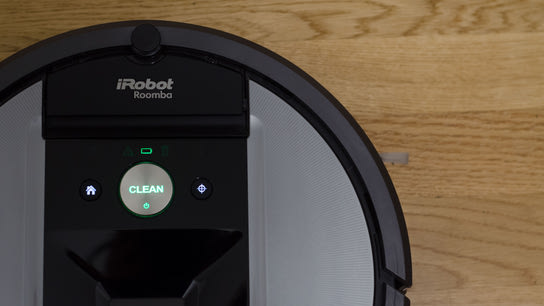I’ve run into an issue two times now where my Roomba 960 won’t setup its own temporary configuration Wi-Fi network. Without it, the robotic vacuum’s app can’t talk to it and you can’t control the vacuum remotely. Here is how I solved this when the manufacturer refuse to document any troubleshooting tips.
By following the normal procedure for configuring the Roomba puts the Roomba in a special mode where it broadcasts its own unsecured Wi-Fi network. The iRobot Home app will look for this network, which is named Roomba-<id>, connect to it, and transmits the information about the local Wi-Fi network configuration from the app to the robotic vacuum.
This all sounds neat in theory, but not so when it the app and Roomba can’t find each other.
I used a Wi-Fi analyzer to verify the problem, and it seems that Roomba — for whatever reason — sometimes won’t setup and broadcast this special network after being put into configuration mode. I tried the normal way to rebooting the Roomba (holding in the Clean button for 10 seconds) but after a restart, the problem still persisted.
As with other products that I’ve documented on this blog, the Roomba’s manual don’t contain any instructions for resetting or even rebooting the product. As its designed to never fail, why would the customer ever need to reset or reboot it? Well, such product design thinking usually only holds water for a few weeks at most when the company don’t put in the engineering work to fulfill the design requirement.
The first time this happened, I let the Roomba sit for a while and tried multiple times to reboot and set it up again using the iRobot Home app. I got nowhere with this, and eventually ended up turning the little robotic vacuum on its head. Then I proceeded to unscrew the battery compartment, and remove the battery before placing it back in again.
The first time I did this I took it out for about five seconds before reinserting the battery. This however, didn’t work. I’d to go in a second time, remove the battery, and then leave it disconnected for a full minute before reinstalling it.
When I next started the Roomba, and held the Dock and Spot buttons (the two smaller buttons on top of the Roomba 900-series) pressed for 5 seconds. My Roomba then started broadcasting the temporary configuration network as expected, and the iRobot Home app could connect and convince the robot to join my home Wi-Fi network.
Nothing may ever beat “turning it off and on again” when it comes to troubleshooting technology issues. However, that mantra should be updated to account for modern battery powered gadgets and devices that aren’t fully powered down when using their on/off buttons (if they even have one!.) My proposal may not be as catchy as the old mantra, but more accurate: “Actually power down and try again.”
Other issues
Roombas only support the legacy 2,4 GHz Wi-Fi standard. Older versions of the iRobot Home app would always assume any Wi-Fi network was 2,4 GHz-capable. Your smartphone would know whether your network supported 2,4 GHz, 5 GHz, or both — but iRobot didn’t check to make sure.
This resulted in annoying issues with the app trying to set up Roombas with Wi-Fi networks that they didn’t support. If you kept doing this repeatedly, the vacuum could eventually stop working and required a restart.
This problem has since been fixed and the iRobot app now insist you provide it wit credentials for a 2,4 GHz network.
